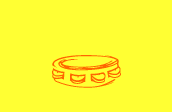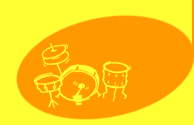The Veena:
The veena is India’s national instrument.
It is the oldest and the
most authentic of all Indian instruments. The origin of the veena can be traced
to India’s Vedic period. This instrument allows all the delicate quartertones
and the subtle nuances to be played with accuracy. Archeological digs have
uncovered gold coins from the Gupta regime inscribed with Emperor Samudragupta
(330-375 A.D.) playing the harp, a form of veena.
The classifications of the musical instruments can be done based on
the way the sound is produced. This was according to Bharata (500 B.C.) from
India and also by Erich Von Hornbostel and Curt Sachs’s publication from 1914.
Chordophones, Aerophones, Membranophones and Idiophones are the four
classification and the veena falls under the Chordophones category[1].
The
shape of the veena can be described from three different angles…
1) the spiritualistic and mythological,
2) the symbolic and
3) the
scientific.
The spiritualistic and mythological approach…The
Hindu goddess of knowledge and wisdom,
Saraswathi plays the veena. The Hindu epic, Ramayana has a reference to the
celestial being Saint Narada singing the praises of Vishnu while playing the veena.
It is also a Hindu belief that Narada was the one who brought music to the
Earth. The Vedas mention the instrument veena. According to the history, the
Vedic veena had five parts, the siras
or the head, the udara or
the bowl, the ambhana or the
sounding board of the belly, the tantra
or the string and the vadana or the
plectrum [2].
There is also the story about one of the Hindu trinity Siva, the god of
destruction created veena upon seeing his wife Parvathi sleeping with her hand
across her breasts, hence the shape of the veena with two globular parts and
the finger- board in between. The Hindu philosophy reflects on the metaphysical
understanding of Man in relation to the Supreme power, that is jeevatma, the individual to paramatma,
and the Universal principal[3]. The
veena has four main strings to
play the melody and three side strings to provide the drone. Because they are
pulled frequently to play the melody the four main strings go out of tune while
the side strings pretty much stay in tune because they are only strummed and
there by used as reference in re-tuning the main strings. This can be compared
to the Hindu philosophical concept of the individual or the jeevatma strayed by the Karmic actions,
the paratma remaining changeless.
The symbolic approach…The
veena is often compared to the human body. Its big bowl (kudam) is like the human head. The finger- board that
is connected to the curved end with the dragon or yali is compared to the human spinal column. The 25
frets are compared to the vertebrae and the 25 principles in Yoga. The black
wax in which the frets are set is supposedly the illusion that human beings
endure. The dragon itself symbolizes the triumph over evil and courage. The
pegs or the birudais are the
symbol of mind that controls everything.
Four is a universally important number. For an example there are
four directions, four seasons, four Vedas and according to the Hindu belief
there are four ages, krta, treata, dvapara and kali and the four stages in a human’s life, dharma (duty), artha (material gain),
kama(love and lust) and moksha (ultimate salvation). The Christianity has the
cross that is four sided and there are four gospels, etc. The veena has four
main strings to symbolize all of the above. In the Hindu tradition everything
is done three times. For an example the sacred verses are repeated three times,
there are three main gods, Brahma the creator, Vishnu the protector and Siva
the destroyer etc. The veena’s three side strings can be compared to that
concept.
The scientific approach… The veena’s
big bowl is hollow to allow the sound to resonate and
travel. The finger- board with its 25 frets are attached to it with enough room
for the player to put his/her arm around it to press between the frets to
produce the notes. The kudukai
or the smaller bowl is also hollow and used to be made out of pumpkin shell in
the old days, then out of metal and out of fiber glass in the modern days and
also functions as a resonator and also helps the player to rest the veena on
his/her lap. The frets are set at distances carefully calculated according to
acoustic physics to produce the twelve-tone scale that emerged around the 7th
century A.D. The four strings are of different thickness and tuned to different
notes in different octaves to allow the veena to have three and a half octaves.
The three side strings are strummed at appropriate places to keep control of
the rhythm.
The
evolution of the veena can be studied under different categories…
1)
The varieties of veenas mentioned in sacred literatures.
2) The number of parts
and their dimensions
3) The shape of the resonators
4) The number and kind of
frets
5) The systems of tuning
6) The purposes for which the veenas were used[4]
The veena went through a very extensive period of evolution and it can
be summed up in seven main
stages.
First there
was the Harp stage. When the primitive
man was hunting with his bow and arrow, heard
the sound emerging from the string of the bow and was fascinated by it. This
fascination lead to the creation of the musical bow by tying strings of
different lengths to the same bow that produced different sounds when plucked
and became the Harp. But
unlike the Western harp, the Indian one had no front pillar.
Then came the harp with a resonator where a gourd was fixed to the
bow to amplify the sound.
Then came the tuning pegs. The strings were tied to the pegs on one
end and to the bow on the other end that made it possible for the player to
increase or decrease the tension of the strings by turning the pegs. Then the
idea of pressing the string at various places to produce different sound came
and the Lute emerged.
Then around the 8th century the first veena
with two large gourds
emerged and it can be seen in the painting in Ellora caves.
The
fifth stage of the evolutionary process was the discovery of
veenas with plain fingerboard without frets and were played with a bow or by
plucking. These veenas are called Nissari
Veena. These can be seen in paintings in Ajantha caves.
The
next stage was the veenas with frets for the left half of the
fingerboard. These were called the Saari
Veena and can be seen in South India’s Halebid and Belur sculptures.
Then came the modern veena, the one that
is used widely today. This
is the veena with 24 fixed frets and a Meru
(the first fret to produce the first note Sa).
This was attributed to Govinda Dikshitar, the minister to the ruler of Tanjore (a city in South India that is known as the
musical seat of Southern India), Raghunatha Nayak and for that reason this
veena is also called the Tanjore Veena.
This allows the player to play two octaves on a single string.
The Tanjore veenas have two major varieties, the Ekanta or veenas carved out of single piece of wood and
the ottu or veenas that are
made from three pieces and joined together. These veenas are made out of wood
from a tropical tree called the Jack Fruit
tree. The reasons for this choice of wood are the abundant
availability and their resistance to termites. Veenas are also made in Mysore,
Trivandrum and Andhra Pradesh in
South India. In Mysore and Trivandrum Rose wood is used to make veenas.
With the invention of airplanes, the world has shrunk a lot in the
recent years, allowing artists to travel all over the world to perform. This
necessitated the invention of detachable veenas. Recently veenas are also made
with built in electronic amplifiers.
[1]An Introduction To The Vina by
Dr.
Kraikudi S. Subramaniam
[2]Prof. P. Sambamurthy's Vina Through
The Ages
[3]An Introduction To The Vina by
Dr.
Kraikudi S. Subramaniam
[4]Prof. P. Sambamurthy's Vina Through
The Ages
Durga Krishnan
(For the Lecture Demonstration at Museum of
Fine Arts on December 4, 2006)
Courtesy of www.nescm.com



